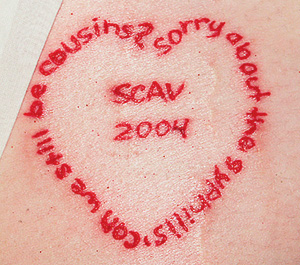The U. of C. is known as the place where fun goes to die — except for the four days in May when students will do anything to buck the stereotype. The new book We Made Uranium! (U. of C. Press) pays homage to the school’s 32-year-old extreme scavenger hunt, with essays from alumni about the fanatical lengths they went to in their quest to complete items on the list, including these four:

Item:“A permanent tattoo (we’re talking the real deal) that reads, ‘Sorry about the syphilis, can we still be cousins?’ [69 points]”
Solution:It’s one thing to have an everlasting reminder of youthful folly. It’s a whole other level of cringe when that tat replicates the item’s wording verbatim, as one contestant had inked in 2004. It remains to this day.
Item:“Do anything for love, but don’t do that. [1 point]” “Do that. [33 points]”
Solution:After getting a thumbs-up from a judge for a Meat Loaf–themed comic book, a student said she was glad she didn’t have to actually do the thing she wouldn’t do: ask her boyfriend to marry her. The judge did an about-face and ruled no point unless she proposed. So she did. She and her boyfriend married two years later.
Item:“We want to play SearsTris Tower (or alternatively, HanTrisCock). Make Alexei Pajitnov proud. [222 points. 25 bonus points if it is set to appropriate music.]”
Solution:Sending commands via phones from outside, one team coordinated a dormful of students in 2003 to open and close their blinds in an elaborately choreographed, building-size game of Tetris, until the pattern reached halfway up the structure.
Item:“A breeder reactor built in a shed, and the boy scout badge to prove credit where credit was due. [500 points]”
Solution:In the titular effort, a pair of students literally generated minuscule amounts of uranium and plutonium by building a rudimentary nuclear reactor in 1999. All it took: a teensy amount of radium from old military gauges, thorium dioxide from trashed TV tubes, and some scrap metal. And, you know, the arrogance to create weapons-grade radioactive isotopes in a college dorm.



